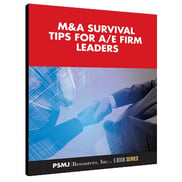
With a new year comes new budgets, new thinking, and new ideas. It may also bring a refreshed level of energy to tackle to some challenges that have been lingering for some time. One challenge may be related to making that first acquisition to enter a new market or finding the right strategic buyer to secure long-term succession planning objectives.
But, a big mistake that we see too many architecture/engineering (A/E) firm leaders making on the M&A front is venturing into uncharted territory without the latest tools and insights for success. For starters, when it comes to M&A, the strategy comes before the transaction…not the other way around.
Sound M&A strategy starts with a sound strategic plan. With this being the season for strategic planning, we’ve got some tips for getting it right before you go jumping head-first into any merger or acquisition plans. So many strategic planning sessions go badly due to poor organization and meetings that veer off of the agenda. Discussions can become mired in day-to-day operational detail instead of focusing on the long term. Thorough preparation is key to avoiding these problems and building an efficient and productive planning session. To this end, following are four tips for effective strategic planning:
1. Get away. Schedule your two to three planning days at a comfortable, quiet place away from the office. You can’t concentrate on planning for the future when reminders of your day-to-day responsibilities surround you.Tell people back at the office not to contact you unless there is a dire emergency (if your firm can’t run without its leadership team for a couple of days, you should probably be addressing leadership issues as part of your strategic plan).
2. Bring data. You’ll need data when you discuss your strengths and weaknesses. Otherwise, the discussion will bog down with anecdotal evidence, which doesn’t provide you with the numbers you’ll need to set measurable goals.At the same time, it is important not to get loaded down with too much data. Computer systems make it easy to collect numbers, but numbers don’t equal knowledge or understanding. Decide what types of data are important for your own firm, your current situation, and your future.
3. What makes a good meeting? Your planning time is valuable: Don’t waste a minute of it. Give some attention in advance to each of the following factors. These factors will make your meeting productive:
-
The right people and only the right people
-
Clearly defined purpose and desired outcomes
-
A good facilitator
-
A time and place conducive to create thought
-
An agenda devised with your facilitator and sent to participants before the meeting
-
Adhering to the agenda—revise it only with a consensus of the participants
-
Specified starting times, ending times and break times
-
Clearly defined roles that people know in advance
-
Self-discipline on the part of participants to adhere to the purpose and the agenda
-
Time allotted to defining next steps and who is responsible for them, and scheduling next meetings
4. The right environment. The following are ground rules developed over the years by PSMJ Resources to assure that all meeting participants understand how they are expected to behave. Each participant should agree to these before starting the meeting:
-
All participants are expected to express their opinions openly and honestly.
-
You have an obligation to speak up if you disagree.
-
No one will be criticized for voicing and honest opinion.
-
Self-serving comments are OK, if they are properly identified as such.
-
Objective is to reach consensus, defined as follows:
-
The majority is in favor.
-
Those opposed are willing to support the decision.
-
-
All discussions will remain strictly confidential.
-
Make sure the sessions start on time. Anyone arriving in meeting room after any scheduled start time will pay a $1 late fee
If you (or one of the other firm leaders on your team) have decided that this is the year to get started on an acquisition or a firm sale, get off on the right foot. It may be tempting to get right into the thick of negotiations and dealmaking, but time spent in the initial strategic planning phase (well before any specific transaction is under review) will be time well spent and will provide a much-needed framework for evaluating a potential transaction and their ability to bring the firm closer to its strategic objectives.
 Merger & Acquisition (M&A) activity in the architecture and engineering space is certainly on the upswing and well on its way to reaching pre-recession levels. But, how ready are you for taking on the task of buying or selling an A/E firm? If you are looking for tips to help your firm navigate through the M&A process, check out PSMJ complimentary ebook M&A Survival Tips for A/E Firm Leaders.
Merger & Acquisition (M&A) activity in the architecture and engineering space is certainly on the upswing and well on its way to reaching pre-recession levels. But, how ready are you for taking on the task of buying or selling an A/E firm? If you are looking for tips to help your firm navigate through the M&A process, check out PSMJ complimentary ebook M&A Survival Tips for A/E Firm Leaders.
Other M&A Related Posts
Recent A/E/C Mergers & Acquisitions
Expert Interview: Assessing Current M&A Market Conditons and Trends



